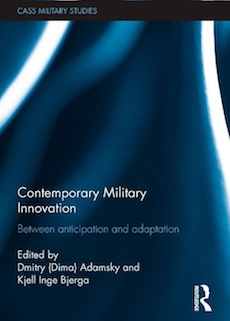Contemporary Military Innovation: Between anticipation and adaptation
by: Dima Adamsky and Kjell Inge Bjerga. (Eds.)
Abingdon, UK: Routledge, 2012.
 The key to this excellent collection of essays on military planning and practice is in the subtitle, anticipation and adaptation. There is an innovation considered – the so-called Revolution in Military Affairs (RMA) – but it is only an anticipated innovation, one yet to be fully proven on the battlefield against a capable opponent and able to force the reshaping of contemporary militaries. There is indeed much adaptation, but it is the usual operational adjustments wise militaries make in combat when their expectations of the fight are proven incorrect.
The key to this excellent collection of essays on military planning and practice is in the subtitle, anticipation and adaptation. There is an innovation considered – the so-called Revolution in Military Affairs (RMA) – but it is only an anticipated innovation, one yet to be fully proven on the battlefield against a capable opponent and able to force the reshaping of contemporary militaries. There is indeed much adaptation, but it is the usual operational adjustments wise militaries make in combat when their expectations of the fight are proven incorrect.
The RMA is one of the terms used to describe the networking of targeting information and precision weapon attacks that US military research and development efforts has been seeking since the middle of the Cold War, and that the Soviets came to describe and worry about in the war’s twilight. It was a kind of technological capability that the Soviets feared that they could not match, characteristically assuming that the American military would surely soon achieve everything they imagined possible. Harvard’s Stephen Peter Rosen outlines how Andy Marshall, the legendary director of the Pentagon’s Office of Net Assessment, skillfully brought the Soviet views of future war into US doctrinal debates. Rosen notes though that the collapse of the Soviet Union and the al Qaeda attacks took the impetus out of the drive for transformational change.
Antulio J. Echevarria II, a professor at the Army War College, follows with a discussion of how the America armed services met the post Soviet challenge by inventing concepts like Rapid Decisive Operations, Network-Centric Warfare and Effects Based Operations to stake out doctrinal territory in Washington budget wars. Washington’s allies and opponents are left to puzzle out whether the supped-up rhetoric involved real doctrinal change. As Kjell Inge Bjerga and Torunn Laugen Haaland, professors at the Norwegian Institute for Defence Studies, point out small allied countries, Norway for certainly among them, need to line up doctrinally with United States both to gain some modest interchangeability with their powerful friend and to show locals how up to date their militaries are. China, as described by Jacqueline Newmeyer Deal of the Long Term Strategy Group, has the need to take American doctrine writing seriously enough both to develop counters and to claim the capabilities for themselves. Their military theorists are, it seems, as confused as their jargon laden American counterparts.
The most interesting reaction to American RMA aspirations comes from the Islamists who have had to counter American military might in the wars that followed the al Qaeda attacks. Their thinking, effectively captured by Itai Brun and Carmit Valensi, both Israelis, is called the Other RMA (O-RMA) and involves thwarting targeting capabilities by concealment and causing the loss of American domestic support by generating American casualties , the RMA of course being the technological magic that is supposed to create quick victory while minimizing everybody’s casualties. The O-RMA’s victory is achieved, as Brun and Valsensi point out, by not losing.
That brings us to the adaptation part of the collection. Here there seems to be a missing chapter. The editors in their introduction discuss Stephen Biddle’s appraisal of the RMA’s limitations in dealing with the Iraq and Afghan insurgencies, citing his “chapter” although one by Biddle, a noted American security studies expert affiliated with the Council on Foreign Relations, does not appear in the volume. What do are essays on the British experience in Helmand province Afghanistan by Theo Farrell and James A. Russell on US military operations in Anbar and Ninewa provinces in Iraq. Farrell, a professor at King’s College in London, analyzes the adjustments six British brigades made during their successive six month deployments to Helmand, emphasizing their on the job relearning of counter-insurgency (COIN) doctrine resulting in their moderation of the use of force and a growing concern for population protection and civic development. For a less charitable view of the same experience see Rajiv Chandrasekaran’s Little America: The War within the War in Afghanistan. Chandrasekaran is a Washington Post reporter who accompanied the US Marines who replaced the British in Helmand.) Russell, a professor at the US Naval Post-Graduate School, describes the operational transformations of Marine and Army units assigned to western and northern Iraq during some of the most intense fighting of that war. They too become COIN experts. Praised are the adaptors.
Rolf Hobson, also a professor at the Norwegian Institute for Defence Studies, tops off the volume with a surprisingly hard hitting essay on Blitzkrieg and the RMA. He argues that the RMA theorists, primarily American defense intellectuals, idealize Blitzkrieg, making it a backward projection to their preferred way of war when it was little more than a desperate race to achieve victory by the resource limited and totally vicious forces of an evil regime. He believes that there is nothing to learn from German generals other than it is easy to take yourself deep into ultimately unwinnable wars. The RMA advocates, the COIN adaptors, and even the sainted Samuel Huntington earn no praise from Hobson.
—
Harvey M. Sapolsky is Professor of Public Policy and Organization, Emeritus at the Massachusetts Institute of Technology.